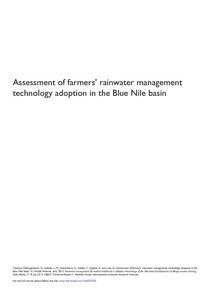Resource information
Agricultural productivity in Ethiopian highlands is constrained mainly by high climate variability. Although use of soil and water conservation technologies is recognized as a key strategy to improve agricultural productivity, adoption of technologies has been very low as farmers consider a variety of factors in their adoption decision. This study assesses the adoption pattern of interrelated rainwater management technologies and investigates factors that influence farm household adoption and scaling-up of rainwater management technologies and draws recommendations for policy. Our results show that rainwater management technologies are interdependent to each other implying that technology adoption decisions need to capture the spillover effect on the adoption of other technologies and have follow a multi-dimensional approach. Moreover, our results suggest that instead of promoting blanket recommendations, it is important to understand the socio-economic, demographic characteristics and biophysical suitability of the rainwater management technologies. Although impact of gender is likely technology-specific and generalization is not possible, our result indicates that male-headed households have a comparative advantage in rainwater management technologies adoption in the Nile Basin and suggests the need to address the constraints of women farmers to give them an opportunity to actively participate in rural economic activities.



